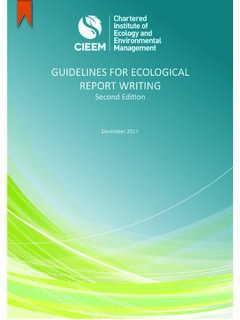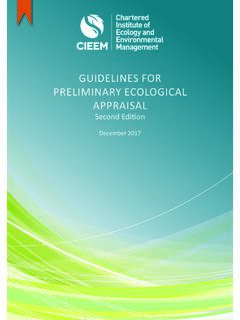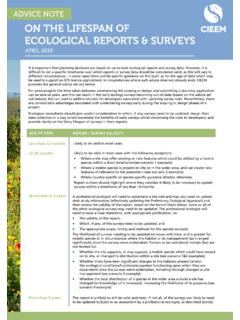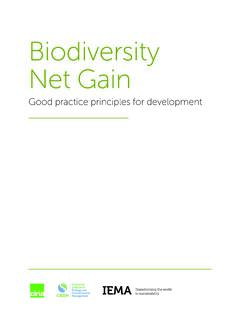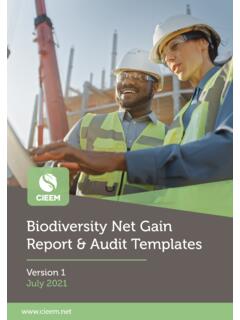Transcription of Biodiversity net gain. Good practice principles for ...
1 CIRIA C776b London, 2019 Biodiversity net gain. Good practice principles for developmentCase studiesTom Butterworth WSPJ ulia Baker Balfour BeattyRachel Hoskin Footprint EcologyGriffin Court, 15 Long Lane, London, EC1A 9 PNTel: 020 7549 3300 Fax: 020 7549 3349 Email: Website: , C776biiSummaryBiodiversity is vital to sustain the UK s society and economy. Improving Biodiversity is integral to sustainable development, and Biodiversity net gain (BNG) is an approach to embed and demonstrate this. Working in partnership, CIRIA, CIEEM and IEMA have recently produced good practice guidance on BNG (CIRIA C776a), which builds on the good practice principles issued in the emergent, but rapidly developing approach to BNG, the project involved extensive consultation with stakeholders. Also, organisations were invited to submit short case studies to illustrate how they are approaching case studies are reproduced in full in this document.
2 Some mention awards or metrics that are relevant to the development described. However, these have not been subject to any form of audit as part of this project and are published as submitted. However, the collection demonstrates the interest and commitment of stakeholders towards achieving 1 is a summary of the case studies identifying some of the key aspects they net gain. Good practice principles for B: Case studiesButterworth, T, Baker, J, Hoskin, RCIRIAC776b RP1048 CIRIA 2019 ISBN: 978-0-86017-791-3 British Library Cataloguing in Publication DataA catalogue record is available for this book from the British LibraryKeywordsEnvironmental management, Biodiversity net gain, Biodiversity offsetting, ecology, ecological impact assessment, environmental good practice , development, planningReader interestDevelopment planning, environmental/ecological assessment, ecological design, construction, Biodiversity offsettingClassificationAvailability UnrestictedContent Advice/guidanceStatus Committee-guidedUser Construction clients, environmental managers and assessors, ecological and other design consultants, planners, contractors, environmental and ecological NGOs, land , Griffin Court, 15 Long Lane, London.
3 EC1A 9 PNThis publication is designed to provide accurate and authoritative information on the subject matter covered. It is sold and/or distributed with the understanding that neither the authors nor the publisher is engaged in rendering a specific legal or any other professional service. While every effort has been made to ensure the accuracy and completeness of the publication, no warranty or fitness is provided or implied, and the authors and publisher shall have neither liability nor responsibility to any person or entity with respect to any loss or damage arising from its rights reserved. No part of this publication may be reproduced or transmitted in any form or by any means, including photocopying, scanning and recording, without the written permission of the copyright holder, application for which should be addressed to the publisher.
4 Such written permission must also be obtained before any part of this publication is stored in a retrieval system of any you would like to reproduce any of the figures, text or technical information from this or any other CIRIA publication for use in other documents or publications, please contact the publishing department for more details on copyright terms and charges at: or tel: 020 7549 net gain. Case studiesiiiTable 1 Case study summaryCase studiesEngaging stakeholdersApplying the mitigation hierarchyDesigning BNG to deliver Lawton s principlesContributing to Biodiversity prioritiesSecuring long-term outcomesBNG activities on site or through offsettingSecuring BNG through a broker or third partyUK-wide legal and policy aims1 Enhancing Biodiversity at Gatwick Airport 2 Ecosystem services valuation, Medmerry scheme 3 2500 homes at land east of Aylesbury (Kingsbrook) 4 Major road maintenance on the A338 (Bournemouth Spur Road) 5 Redevelopment at St Leonards Hospital, Dorset 6 Greater West Programme: Fulscot access road, Didcot 7 Greater West Programme: Hay Lane, Swindon 8 Implementing a new EPS licence 9 Biodiversity net positive pilot.
5 Midland Mainline Programme 10 Biodiversity net positive pilot influences planning 11 Quarry extension at Gill Mill, Witney, Oxfordshire 12 Creation of Priest Hill Nature Reserve, Ewell, Surrey 13 Residential development at Exeter Road, Teignmouth, Devon 14 Protecting cirl bunting at Ashill Nature Reserve, Devon 15 Biodiversity baseline, Transport for London 16 Biodiversity offsetting and GNC pilot, Warwickshire 17 Strategic mapping Solihull, Warwickshire and Coventry 18 Creating new green space at Kidbrooke Village 19 Working in partnership: creating wetland within London 20 Beam Parklands habitat creation, Dagenham, London 21 Bioreceptive built environments, Isle of Wight 22 Enhancing freshwater habitats, Holbrookes Streams 23 Zero environmental impact goal, Corriemoillie 24 Habitat banking process, Tees Estuary Partnership 25 Identifying land for Biodiversity offsets in Paris 26 Renewables and Biodiversity offsets, Scottish Borders Council 27 Living roof enhancement, Bolsover 28 Enhancing Biodiversity on large-scale solar farms 29 Links to further case studiesCIRIA, C776bivAcknowledgementsThis guide is the result of research project RP1048 managed by CIRIA in partnership with CIEEM and IEMA.
6 It was carried out under contract by a consortium with Balfour Beatty, Footprint Ecology, WSP, Natural England and Forest ButterworthTom Butterworth is the technical director for Biodiversity leading the work on Biodiversity net gain and Biodiversity offsetting for WSP. Tom has over 20 years experience working for wildlife. Over this time Tom has developed and delivered local, regional and national Biodiversity strategies and action plans, led programs of research and managed the delivery of the England s Biodiversity strategy. As Natural England s principal advisor for Biodiversity , Tom gained experience working with developers, wildlife organisations, community groups and local authorities to enable development while supporting Julia BakerDr Julia Baker is the Biodiversity technical specialist at Balfour Beatty, with 20 years experience on Biodiversity initiatives for infrastructure development.
7 She is lead author of the UK s Good practice principles on Biodiversity net gain (CIEEM, CIRIA and IEMA, 2016) and has designed and implemented Biodiversity net gain on a variety of infrastructure projects, including for Network Rail, and highways schemes. Julia is also a visiting researcher at Oxford University, a technical advisor for the Institute of Environment and Development, and a member of the Valuing Nature Partnership s business interest HoskinRachel is a director at Footprint Ecology, a public sector focused consultancy undertaking Biodiversity and planning-related commissions and research. She specialises in embedding protected site and wider Biodiversity -related requirements into local planning authority functions, including preparing policies, strategies, guidance and formal planning documents, along with advising on the processes necessary to enable resourcing and practical implementation.
8 Rachel has previously worked as a national specialist in planning and government advice-related roles within Natural England, and also as a local planning authority ecologist. Rachel is vice chair of the Biodiversity Committee for the British Standards steering groupFollowing CIRIA s usual practice , this work was guided by a project steering group (PSG) that comprised:Sarah Beattie LandsecNick Blyth* IEMAL ouise Clarke Berkeley GroupDiane Crowe CarillionAndrew Griffiths Nestl Neil Harwood ArupSally Hayns* CIEEMOwen Jenkins* CIRIAP eter Johnson KierLouise Morris DefravBiodiversity net gain . Case studiesMichael Oxford Association of Local Government EcologistsChris Plester National GridSarah Pratt Barratt Developments PLCJon Tivey Gatwick AirportClaire Wansbury (chair) AtkinsMike Watson National GridNick White Natural EnglandPaul Wilkinson The Wildlife TrustsStuart Wilson Highways England* partner representativesProject fundersCIRIA project teamOwen Jenkins Project directorJack Young Assistant project managerClare Drake Publishing managerOther contributors and consulteesAs part of the development of this guidance, consultation was undertaken with a range of stakeholders including meetings and webinars.
9 The project partners acknowledge and thank the organisations and over 100 individuals who took part in these , special thanks for the following who provided additional guidance and technical input:Louise Clarke Berkeley GroupSpencer Clubb IEMAMark Coates Barratt HomesHamish Critchell-Ward CarillionHannah Deacon Gatwick AirportBob Edmunds SLRT homas Errett Gatwick AirportNeil Harwood ArupMax Heaver DefraClaire Hempsey DAER ALaura Homfray WSPD onald Kernott Balfour BeattyMark Jourdan IEMASue Lawley Oxfordshire County CouncilJeannine McCool DAERAS tephanie McGibbon ArupDanielle Michalska Barratt Developments PLCH elen Nyul Barratt Developments PLCV ikki Patton WSPC hris Plester National GridAtkinsBarratt Developments PLCB erkeley GroupCarillionGatwick AirportGrosvenor Britain and IrelandKierLandsecNational GridNestl The Wildlife TrustsWSPCIRIA.
10 C776bviJon Tivey Gatwick AirportJohn Uttley Scottish Natural HeritageSiobhan Wiltshire Welsh Assembly GovernmentMichael Winhall CarillionGiuseppe Zanre Barratt Developments PLCB iodiversity net gain. Case studiesviiContentsSummary ..iiAcknowledgements ..ivAbbreviations and acronyms ..x1 Enhancing Biodiversity at Gatwick Airport .. Project summary .. Issues .. Outcomes ..52 Ecosystem services valuation, Medmerry scheme .. Project summary .. Issues .. Outcomes .. Key benefits and success Development of 2500 homes at land east of Aylesbury .. Project summary .. Outcomes ..104 Major road maintenance on the A338 (Bournemouth Spur Road) .. Project summary .. Issues .. Outcomes .. key benefits and success Redevelopment at St Leonards Hospital, Dorset .. Project summary .. Issues .. Outcomes ..196 Greater West Programme: Fulscot access road, Didcot.


